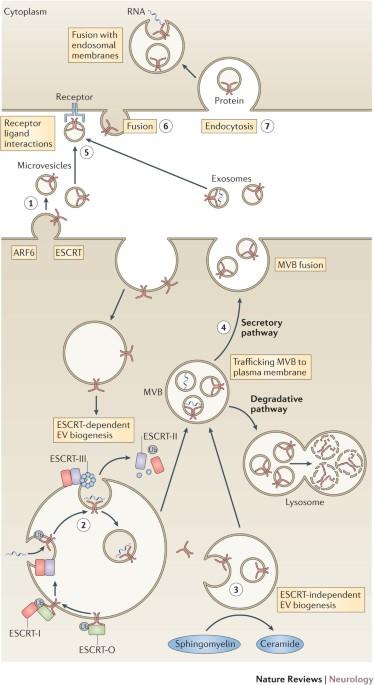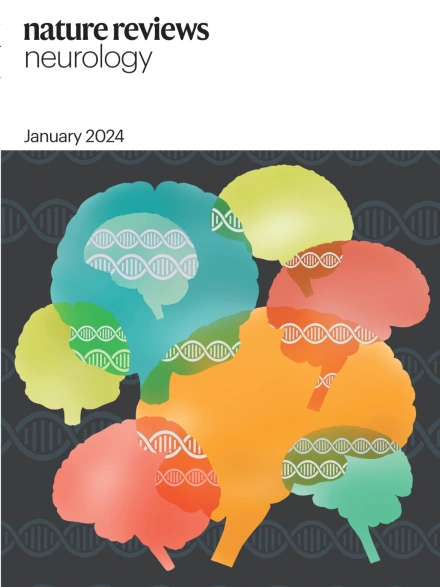神经退行性疾病中的细胞外囊泡--从发病机制到生物标志物
IF 28.2
1区 医学
Q1 CLINICAL NEUROLOGY
引用次数: 261
摘要
大多数细胞类型都会释放胞外囊泡 (EV),它们携带的蛋白质和核酸反映了细胞的来源。汤普森及其同事回顾了目前有关EVs生物学和功能的知识,包括它们参与神经退行性疾病发病机制的证据,以及它们作为中枢神经系统特异性生物标记物的潜力。为开发有效的神经退行性疾病治疗方法,可靠的诊断、疾病活动和进展标志物是研究的当务之急。事实上,神经退行性病变主要与中枢神经系统不同区域的不同细胞亚群有关,这就给相关生物标记分子的鉴定带来了挑战。由细胞外囊泡 (EVs) 介导的大分子从中枢神经系统向脑脊液和血液的迁移是中枢神经系统特异性生物标记物的一个很有前景的来源。几乎所有类型的细胞都会释放 EVs,其携带的蛋白质和核酸因细胞来源而异。EV 的输出随细胞状态的变化而变化,并反映细胞内的事件,因此表面标记物的表达可用于识别 EV 来源的细胞类型。因此,EVs 可以提供有关神经病原核心细胞特异性过程的丰富信息库。本综述探讨了目前有关 EVs 生物学和功能的知识,讨论了 EVs 参与神经退行性疾病发病机制的证据,并探讨了 EVs 作为疾病生物标记物的潜力。本文章由计算机程序翻译,如有差异,请以英文原文为准。

Extracellular vesicles in neurodegenerative disease — pathogenesis to biomarkers
Extracellular vesicles (EVs) are released by most cell types, and they carry a cargo of protein and nucleic acid that reflects the cell of origin. Thompson and colleagues review current knowledge of the biology and function of EVs, including evidence for their involvement in neurodegenerative disease pathogenesis, and their potential as CNS-specific biomarkers. To develop effective disease-modifying therapies for neurodegenerative diseases, reliable markers of diagnosis, disease activity and progression are a research priority. The fact that neurodegenerative pathology is primarily associated with distinct subsets of cells in discrete areas of the CNS makes the identification of relevant biomarker molecules a challenge. The trafficking of macromolecules from the CNS to the cerebrospinal fluid and blood, mediated by extracellular vesicles (EVs), presents a promising source of CNS-specific biomarkers. EVs are released by almost all cell types and carry a cargo of protein and nucleic acid that varies according to the cell of origin. EV output changes with cell status and reflects intracellular events, so surface marker expression can be used to identify the cell type from which EVs originate. EVs could, therefore, provide an enriched pool of information about core neuropathogenic, cell-specific processes. This Review examines the current knowledge of the biology and function of EVs, discusses the evidence for their involvement in the pathogenesis of neurodegenerative diseases, and considers their potential as biomarkers of disease.
求助全文
通过发布文献求助,成功后即可免费获取论文全文。
去求助
来源期刊

Nature Reviews Neurology
医学-临床神经学
CiteScore
29.90
自引率
0.80%
发文量
138
审稿时长
6-12 weeks
期刊介绍:
Nature Reviews Neurology aims to be the premier source of reviews and commentaries for the scientific and clinical communities we serve. We want to provide an unparalleled service to authors, referees, and readers, and we work hard to maximize the usefulness and impact of each article. The journal publishes Research Highlights, Comments, News & Views, Reviews, Consensus Statements, and Perspectives relevant to researchers and clinicians working in the field of neurology. Our broad scope ensures that the work we publish reaches the widest possible audience. Our articles are authoritative, accessible, and enhanced with clearly understandable figures, tables, and other display items. This page gives more detail about the aims and scope of the journal.
 求助内容:
求助内容: 应助结果提醒方式:
应助结果提醒方式:


